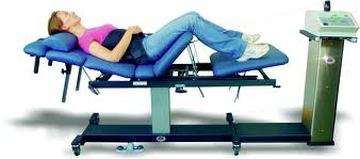Spinal Decompression -vs- Traction
Is There a Difference?
Traction?
Traditional traction which has been used for decades uses force to pull / stretch on the spine. Simple (i.e. ‘cheap’) traction tables use a cheap electric winch with an attached rope to accomplish this. Others are more cleverly disguised. No matter how sophisticated the unit may look (bells, whistles, towers, etc), traction machines mechanically pull on the spine in only one direction.
The problem with traction is that it just pulls and pulls and pulls, and after a few minutes your body says “hey, I’m being stretched!” It reacts by tightening up the muscles (aka “guarding” or “splinting“). This prevents the disc spaces from opening, staying open, and healing properly. No manufacturer of spinal traction devices has been able to show before and after MRI’s where traction was able to increase hydration (height) to the disc or reduce the size of a disc herniation.
Spinal Decompression Therapy?
Spinal Decompression Therapy is a step beyond traction. Spinal Decompression Units not only pull the spine, they actually “sense” how much force the body is pulling back with, and can decrease the amount of pull when needed. This helps prevent the traction-caused muscle spasms that used to be so prevalent with the type of Spinal Traction used in some doctor’s offices.
Our table utilizes a computerized feedback system that senses if your body begins to tighten up. When it does, our Decompression Table automatically backs off. Essentially your body is being tricked into not realizing that it is being “pulled” (Decompressed). Thus, it will not typically cause the back to spasm like Traction Tables frequently do. That is why before and after comparison MRI’s of Decompression patients have actually shown objective improvements in disc hydration, reduction of disc bulges, and reduced nerve impingement (sciatic leg pain). You will see this in the following video
BE WARNED:
Spinal Decompression Therapy has become very popular due to the fact that it works! This technology has spared many people from DANGEROUS SPINAL SURGERIES. Because of this, many manufacturers and doctors have jumped on the “get-rich-quick” bandwagon.
Many of these so called “Spinal Decompression” units are just traction machines that have gone through a makeover to refit them with a lot of pseudo-technology. You know; colored lights, computer screens, digital readouts —– all of the pretty bells, and whistles. Machines that half a dozen years ago were called “traction” units, have magically been re-branded as “Decompression Machines”. Roller Tables are now “Decompression Tables.” Even the simple devices that allow you to hang in various states of inversion are no longer “Inversion Tables” but are now “Decompression” devices. It’s relentless!
None of these machines use computerized feedback. None of them have research behind them proving they work to effectively reverse disc herniations. I am a huge believer in using technology that is backed by research!
Traction -vs- Spinal Decompression Therapy is fairly easy to understand. When you think of traction, think of William Wallace about to be “stretched” (drawn & quartered) at the end of the movie Braveheart. When you think of Spinal Decompression Therapy, think Schierling Chiropractic, LLC. We have the research and and PATIENT TESTIMONIALS that prove Spinal Decompression Therapy helps large numbers of people!
DR. TERRY YOCHUM LECTURES ON THE ABILITY OF SPINAL DECOMPRESSION THERAPY TO CHANGE HERNIATED & DEGENERATIVE DISCS
Nearly 25 years ago, renowned Chiropractic Radiologist Terry Yochum, DC, DACBR, FCCR, FICC of the Rocky Mountain Chiropractic Radiological Center co-authored the definitive radiology textbook still being used in virtually all chiropractic schools (ESSENTIALS IN SKELETAL RADIOLOGY). I used the first edition of the book back in 1988. In fact, this book is so impressive that several medical schools have used this text book as well.
Listen as Dr. Yochum describes the pre and post MRI findings of a fellow chiropractor who had sought his advice concerning a severely herniated disc. By the way, I personally know some of the people involved in this (I studied under Dr. Michael Barry —- Dr. Yochum’s associate).

